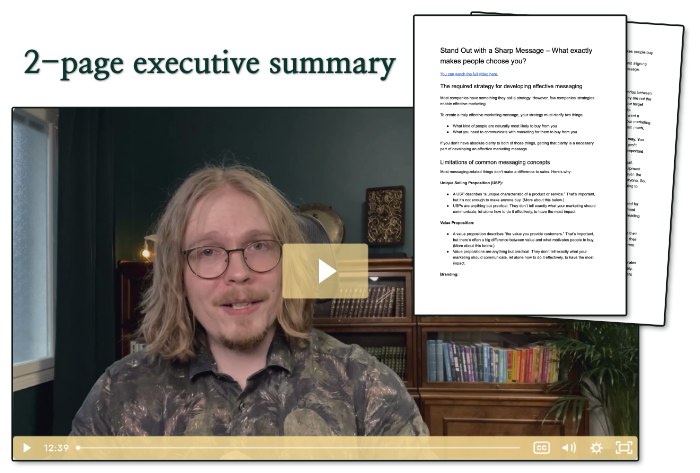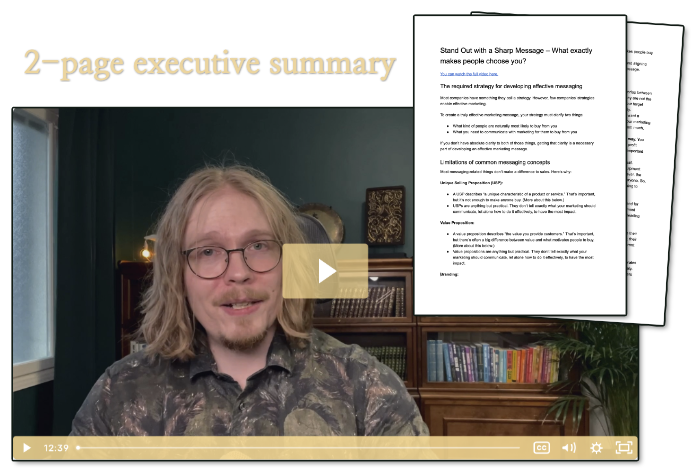Front-end profit could refer to a few things. Now I’m talking about sales of relatively low-cost offers that aim to lead people closer to buying your high-ticket offers. In a different situation, some of the guidelines below don’t apply the same way.
These kinds of front-end offers are not really about the profit. Rather, the more profit they make, the more you can invest in promoting the front-end offers, so you attract more customers who might buy your high-ticket offers later.
Here are a few examples I can share:
- A consulting company sold small-group workshops for about $250. They often closed 50% of the room ($25-50k offers).
- A coach sold 3-day online events for about $100. He filled his $25-50k coaching programs at the end of the events.
- A software company sold a $97 online course. The offer at the end was their ($300/month) software.
Each company reinvested whatever profit the front-end offers made back into advertising the same front-end offers. That fueled incredible growth for years for each company (7-8 -figure revenue in each case per front-end offer per year).
Why up-sells are often the best way to increase front-end profit
There are three ways to increase front-end profit:
- Make more sales
- Increase your prices
- Sell more things (up-sells)
Making more sales, as in increasing your conversion rates, should always be a goal. But once you reach a certain conversion rate, it gets very difficult to increase it further significantly.
Increasing your prices works up to a point. However, the goal is to attract more customers, and the lower the price point, the more sales you usually make (I might write about the exceptions another time). So, soon enough you reach a point where a higher price starts to cannibalize the number of sales too much.
Up-sell offers are often the best way to increase profit. It’s common for up-sell offers to even multiply profit if the primary product/service isn’t very profitable on its own. For example, you only just barely make a profit with your primary front-end offer. If 30% of people buy even one up-sell offer, you might 10x your front-end profit.
But it’s easy to annoy people with up-sell offers.
So, let’s go over a few ways to use up-sell offers effectively without annoying (almost) anyone.
Natural upgrades as up-sell offers
For example, if you sell cars, a leather interior is a natural upgrade. I doubt almost anyone finds it annoying that the option is available. However, if the salesperson badgers a customer about the upgrade options, they’ll find it annoying very quickly.
Something similar that I’ve done is to offer the option to buy some 1-on-1 help with an online course. The option has been next to the just-the-course option on a sales page, so you could choose if you want the additional help up front. I don’t remember getting any negative feedback about it ever.
Directly related products/services as up-sell offers
For example, if you sell clothing, a salesperson should show customers a few other clothing items that would go well with the clothes they’re considering buying. I’d call that good service. However, we’ve probably all experienced a salesperson who’s far too aggressive with the up-sells.
Something I often do is that when someone wants my help with sharpening their messaging, I ask if they would also like my help with applying it to a specific part of their marketing. If they don’t want the additional help, I’ll still go over how to use their new message in marketing, of course. But most people want to make it easier for themselves, so the up-sell is a natural fit. And no one’s ever said anything negative about my offering the additional help.
Indirectly related products/services as up-sell offers
These are the types of up-sells people most often find infuriating. You can use these in a friendly way, too. Just be extra careful.
For example, you buy an online course that guides you through building or modifying your website in a way that will make it generate more leads and/or sales. You then have the option to buy an up-sell offer: a training on how to do effective email marketing. It’s not directly about improving your website results, but it’s related because email marketing can help convert more of the leads your website generates.
That’s an up-sell offer I’ve used. And only one person ever said something negative about it (I had used a poorly-worded headline that was arguably a bit confusing).
But if you’ve bought many things online — especially in the marketing industry — you’ve likely experienced being locked into a seemingly endless string of up-sell offers. The most I’ve seen was 7-8 up-sell offers. At worst, each additional offer has a short deadline (e.g., 5-10 minutes), so you have no time to truly think if it’s something you want. Another extra sleazy tactic is to offer the same up-sell offer again if someone declines it at first, but at a lower price point.
People who use those kinds of tactics point out that their front-end profit has gone up. And that’s often true; you might make more short-term profit with the most manipulative tactics.
However, you’ll have a harder time making high-ticket sales later if you already annoyed people with your front-end offers.
In my experience, you can take almost any sleazy, manipulative sales tactic and turn it into something friendly. You can increase your front-end profit with up-sells in a way that makes people pull their hair out. Or you can do it in a way that makes them send you thank you emails. That might take a bit more effort, but in my experience, it’s worth it… especially if you hope for them to buy from you again.


